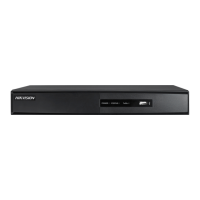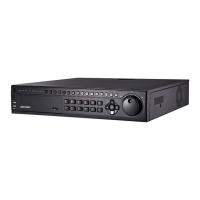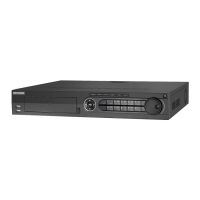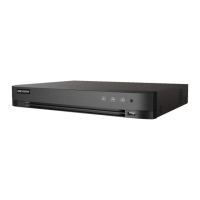
Do you have a question about the HIKVISION DS-7200-SH Series and is the answer not in the manual?
Details FCC compliance and conditions for digital devices, including interference limits.
Outlines compliance with European standards like WEEE and battery directives.
Essential tips for safe installation, operation, and maintenance of the device.
Overview of device capabilities like H.264 compression, dual-stream, and watermark technology.
Features for on-site viewing, including HDMI/VGA output and multi-screen display.
Details on connecting and managing SATA and network HDDs, including group management.
Options for scheduling, types of recording, and playback functionalities.
Description of buttons and indicators on the front panel of DS-7200/DS-7300 series DVRs.
Explanation of how to use the infrared remote control for device operation.
Guide on connecting and using a USB mouse for device interaction.
Details on the soft keyboard layout and icon functions for input.
Diagram and description of all ports and connectors on the rear panel of the DVR.
Step-by-step instructions for safely powering the device on, off, and rebooting.
Step-by-step guide through initial device setup using the wizard for resolution, time, and network.
Explanation of the live video display and status icons.
How to use single/multi-screen, auto-switch, start recording, and manage output modes.
Customizing output interfaces, dwell time, audio, and screen order for live view.
Optimizing bandwidth for remote viewing by reducing stream quality for multiple channels.
Steps to log out of the system, returning to live view mode.
Setting up communication parameters like baud rate and protocol for PTZ cameras.
Configuring specific camera positions, movement paths, and sequences for PTZ cameras.
Explanation of icons and functions within the PTZ control interface.
Setting stream types, resolutions, bitrates, and pre/post-record times for recording.
Defining daily or weekly schedules for automatic recording based on time or event type.
Setting up motion detection areas, sensitivity, and triggering recording or monitoring.
Configuring recording or capture based on external alarm inputs.
Manually starting and stopping recording, which takes priority over scheduled recordings.
Setting up specific recording schedules for holidays, separate from regular schedules.
Enabling a second HDD to mirror recordings for data safety and reliability.
Organizing multiple HDDs into groups for managing storage and recording distribution.
Methods to protect recorded files from overwriting by locking or setting HDD to read-only.
Methods to search and play back recorded video by channel, time, event, or system log.
Advanced playback features like frame-by-frame viewing, smart search, and digital zoom.
Procedures for exporting recorded files using Quick Export, Normal Video Search, Event Search, or Video Clips.
Managing connected USB drives, HDDs, writers, and DVD-RWs, including formatting and deletion.
Configuring motion detection zones, sensitivity, arming schedules, and alarm response actions.
Configuring external sensor inputs, arming schedules, and alarm response actions.
Setting up alarms and response actions for detected video signal loss.
Configuring alarms and response actions for video tampering events like lens cover.
Configuring response actions for various system exceptions like HDD full or network disconnect.
Defining actions like full-screen monitoring, audible warnings, email notifications, or alarm output upon an event.
Manually activating or deactivating alarm outputs for specific or all alarm channels.
Setting up basic network parameters like IP address, subnet mask, and DNS server.
Configuring advanced network protocols and services like PPPoE, DDNS, NTP, SNMP, UPnP, and remote alarms.
Monitoring real-time network activity, including linking status and transfer rates.
Testing network connectivity, delay, packet loss, and exporting network packets.
Preparing newly installed hard disk drives for use by the device.
Adding and configuring NAS or IP SAN devices as network HDDs.
Organizing multiple HDDs into groups for specific recording purposes.
Allocating specific storage quotas for recorded files per camera.
Monitoring the operational status and health of installed HDDs.
Accessing Self-Monitoring, Analysis, and Reporting Technology data for HDD reliability.
Scanning HDDs for bad sectors that may affect reading or writing performance.
Setting up alarms for HDD errors or uninitialized/abnormal states.
Customizing on-screen display elements like date, time, and camera names.
Defining zones on the video feed that will be obscured for privacy.
Adjusting image settings like brightness, contrast, and hue for different lighting conditions.
Accessing details about the device, cameras, recording, network, and HDD status.
Finding, viewing, and exporting system operation, alarm, and exception logs.
Backing up and restoring device configuration settings, or applying them to multiple devices.
Updating device firmware using local backup devices or remote FTP servers.
Resetting device parameters to factory default values, excluding network settings.
Adjusting general device parameters like language, resolution, and mouse speed.
Setting up parameters for the RS-232 serial port for configuration or device control.
Setting up Daylight Saving Time adjustments, either automatically or manually.
Configuring device name, number, CVBS brightness, operation timeout, and menu output mode.
Creating, editing, deleting, and managing user accounts and their permissions.
Procedures for logging out users, shutting down, or rebooting the device.
Definitions of technical terms and acronyms used in the manual.
Answers to common questions regarding device behavior and troubleshooting.











